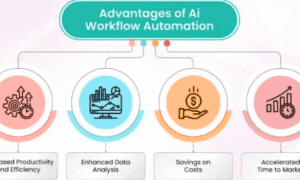Welcome to a pioneering era in environmental monitoring, where state-of-the-art technology converges with our pressing demand for sustainable solutions. Today, we delve into a groundbreaking innovation that harnesses the potential of satellite data analytics empowered by artificial intelligence (AI). As our world grapples with unparalleled challenges such as climate change, deforestation, and pollution, the fusion of these cutting-edge technologies offers fresh insights and actionable strategies. Join us as we embark on an exhilarating journey through the boundless possibilities presented by AI-driven satellite data analytics, poised to revolutionize endeavors in environmental conservation. Prepare to witness how these digital guardians are reshaping the way we protect our planet!
Introduction to Satellite Data Analytics and AI
The integration of satellite data analytics and artificial intelligence (AI) represents a new frontier in environmental monitoring. Through the application of these technologies, we can glean insights previously unattainable, enhancing our comprehension of and efforts to safeguard our environment.
Satellite data analytics involves extracting information from satellite images to discern patterns and trends in the environment, such as shifts in land use or vegetation coverage. AI techniques can then interpret this data, offering invaluable insights into ecosystem health and the impact of human activities on the environment.
This combination of satellite data analytics and AI is already yielding diverse benefits in environmental monitoring. It aids in real-time mapping of deforestation, tracking illegal fishing operations, and monitoring air quality. Yet, this is only the beginning – as these technologies evolve, we anticipate even more exciting applications on the horizon.
Advantages of AI in Environmental Monitoring
The advantages of utilizing AI for environmental monitoring are numerous. Most notably, AI enhances our ability to accurately observe and forecast environmental changes. By analyzing satellite data, we gain deeper insights into the effects of climate change on our planet. Additionally, AI assists in resource management, such as conserving water and energy. Through meticulous monitoring of environmental data, we can make informed decisions to protect our surroundings. Furthermore, AI aids in detecting and monitoring environmental offenses, such as illegal logging or fishing, enabling us to bring culprits to justice and prevent future transgressions.
Enhancing Environmental Monitoring Accuracy with AI
AI introduces novel avenues for environmental monitoring, notably in detecting and quantifying environmental shifts with heightened accuracy. AI-driven satellite data analytics play an increasingly pivotal role in this field, providing timely, actionable insights to decision-makers.
AI-fueled satellite data analytics facilitate monitoring various environmental parameters, encompassing air and water quality, land usage, and deforestation. For instance, AI can track air pollution by scrutinizing satellite images to identify and quantify emissions from industrial sources. It can also monitor water quality by detecting algae blooms and gauging water clarity. Furthermore, AI aids in tracking land use changes and deforestation by pinpointing cleared areas in satellite images.
By delivering precise, prompt information on environmental conditions, AI-powered satellite data analytics empower decision-makers to take proactive measures in preserving our planet.
Revolutionizing Object Detection via Satellite Imagery and AI
Object detection through satellite imagery and AI marks a new paradigm in environmental monitoring. Leveraging machine learning, we can automatically identify objects in satellite images with exceptional accuracy. This breakthrough opens doors to diverse applications in environmental monitoring, enabling us to track deforestation, agricultural land usage, and even illicit mining activities effortlessly.
Though this technology is nascent, its potential applications are limitless. It could aid in monitoring the influence of climate change on our environment or tracking the proliferation of invasive species. The possibilities are truly endless, as we merely scratch the surface of this technology’s capabilities.
Land Cover Classification through Satellite Imagery and AI
The deployment of artificial intelligence (AI) for land cover classification signifies an avant-garde approach to environmental monitoring. With ever-improving satellite data resolution, AI can classify land cover automatically at elevated resolutions. This affords more accurate, timely tracking of land cover shifts, pivotal for understanding and managing our environment.
Numerous methodologies exist for land cover classification using satellite data, with most relying on machine learning. Machine learning empowers computers to learn from data sans explicit programming. Within land cover classification, machine learning algorithms can be trained on labeled datasets to differentiate between diverse land cover types. Once trained, these algorithms can classify land cover in new datasets autonomously.
AI-driven land cover classification offers myriad benefits. It accelerates processes and reduces costs in comparison to traditional methods demanding manual interpretation of satellite images. Moreover, it yields more precise and consistent outcomes than manual interpretation alone. The capacity to rapidly process substantial data volumes is indispensable for promptly monitoring land cover changes.
Urban Mapping with Satellite Imagery and AI
AI’s role in environmental monitoring presents a captivating frontier, particularly in urban mapping. Given the copious satellite data accessible, AI aids in comprehending this information and extracting valuable insights about our cities.
For instance, AI can identify patterns in satellite imagery indicative of pollution or other environmental issues. It also facilitates monitoring urban changes over time, valuable for planning future development and identifying potential trouble zones.
With appropriate tools and data, AI could transform urban mapping, furnishing a wealth of fresh insights into our cities.
Challenges Confronting AI in Environmental Monitoring
AI introduces both challenges and opportunities to environmental monitoring. Coping with vast data volumes is one challenge, necessitating efficient processing to derive valuable information. Ensuring accurate labeling of datasets is another challenge, imperative for training AI algorithms. Standardizing diverse data sources poses yet another challenge, complicating result comparisons across studies.
Despite these hurdles, AI holds immense potential for enhancing environmental monitoring. It uncovers patterns often elusive to traditional methods and automates tasks like data collection and analysis, freeing time for more vital work. AI optimizes data utilization by amalgamating and synthesizing information from myriad sources.
Conclusion
Satellite data analytics, empowered by artificial intelligence, heralds an innovative and promising epoch in environmental monitoring. AI-infused solutions swiftly and accurately process extensive data, enabling researchers to gain invaluable insights into Earth’s climate and environment more efficiently than ever. With satellites and AI in concert, we gain real-time access to pivotal information about our planet, bolstering our understanding and fortifying a healthier future for all life on Earth.”



































